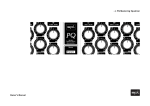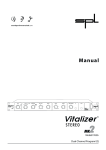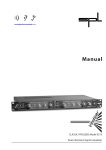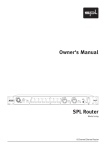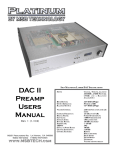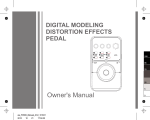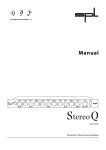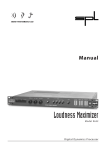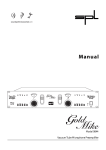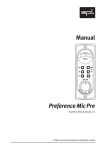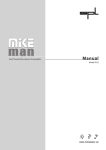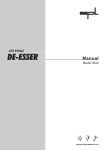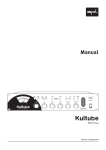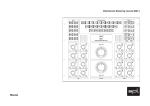Download Sound Performance Lab 9530 User's Manual
Transcript
Manual TUBE VITALIZER Model 9530 Program-Equalizer Tube Vitalizer Model 9530 Manual By Hermann Gier and Paul White Version 3.1 - 5/2000 The information in this document has been carefully verified and is assumed to be correct. However Sound Performance Lab (SPL) reserves the right to modify the product described in this manual at any time. Changes without notice. This document is the property of SPL and may not be copied or reproduced in any manner, in part or full without the authorisation of SPL. Limitations of Liability: In no event will SPL be liable for any damages, including loss of data, lost profits, cost of cover or other special, incidental, consequential or indirect damages arising from the use of the unit, however caused and on any theory of liability. This limitation will apply even if SPL or an authorised dealer has been advised of the possibility of such damage. SPL electronics GmbH Postal address: P.O. Box 12 27 D- 41368 Niederkruechten, Germany Phone + 49 - 21 63 / 98 34-0 Fax + 49 - 21 63 / 98 34-20 eMail: info@ soundperformancelab.com www.soundperformancelab.com © 1999 SPL electronics GmbH. All rights reserved.VitalizerTM is a registered trademark of SPL electronics GmbH. Foreword ........................................................................ Thanks ............................................................................. Operation safety .......................................................... Introduction .................................................................. Connections .................................................................. 4 4 4 5 6 Applications Recording Studio ..................................................... Tape Duplication ..................................................... Broadcast ................................................................... Sound Reinforcement ............................................ Video & Film Post Production .............................. 7 8 8 8 9 Contents First Steps .................................................................... 10 Control Elements Activate Process (1) ................................................. 11 Drive (2) ...................................................................... 11 Bass (3) ........................................................................ 11 Bass - LC Filter (4) ..................................................... 12 Bass Comp. (5) ........................................................... 12 Hi-Mid Freq. (6) .......................................................... 13 Process Level (7) ....................................................... 15 High Freq. (8) ............................................................. 16 Intensity (9) ............................................................... 16 High - LC Filter (10) ................................................... 17 High Comp. (11) ....................................................... 17 Activate Tubes (12) .................................................. 18 Attenuator (13) ......................................................... 18 Atten./Limit (14) ....................................................... 19 VU In/Out (15) ........................................................... 19 Tube Status (16) ........................................................ 19 Power Supply ................................................................ 20 Specifications ............................................................... 21 Warranty ......................................................................... 22 TUBE VITALIZER 3 Foreword Dear Customer, Thank you for the confidence you have shown towards SPL electronics GmbH by purchasing the SPL Tube Vitalizer. You have decided to use a tool of high performance which sets you in the position to have faster success and a better sound quality in your music productions and pre-masterings. As a typical SPL unit the Tube Vitalizer combines exemplary specifications and high manufacturing standard with excellent sound quality to provide you a precious component for studio and mastering purposes. Please read this manual carefully to ensure you have all the information you need to use it. We wish you every success with the Tube Vitalizer. Your Sound Performance Laboratory-Team Thanks I would like to start with my thanks to all our staff, who created what is to be described here. The importance of their exceptional qualification and talents cannot be overestimated. But the biggest thanks I owe their unbelievable engagement, creativity and productivity in realizing our projects. Our products are often tested and compared in many publications and by our customers themselfs and constantly valued with best results. I would like to pass on this broad appreciation to those, who deserve it – my excellent colleagues. Hermann Gier Operation safety The housing of the Tube Vitalizer has the standard 19" EIA format and occupies 2U (88 mm) in your rack. The Tube Vitalizer should not be installed near units which produce strong magnetic fields or extreme heat. Do not install the Tube Vitalizer directly above or below power amplifiers or digital processors. If possible, the Tube Vitalizer should be placed in an “analog rack”. This eliminates problems which could result from interfering high-frequency signals such as clock frequencies, MIDI or SMPTE signals. Check that the voltage details quoted on the back panel are the same as your local mains electricity supply. Use a minus (-) screwdriver to set the voltage selector to the voltage for the area in which the unit will be used. Never cover up the ventilation slots on the top of the unit. If, during operation, the sound is interrupted or indicators no longer illuminate, or if abnormal odor or smoke is detected, or if liquids are spilled on the unit, immediately disconnect the power cord plug and contact your dealer. Only clean your Tube Vitalizer with a soft, lint-free cloth. 4 TUBE VITALIZER SPL´s Tube Vitalizer is the top-of-the-line product of the Vitalizer range. It is designed for the sound enthusiast in professional recording, mastering and cutting. The effect intensities are optimized for this delicate sound processing. Introduction The Tube Vitalizer combines the finest audio technologies: Tube technology, RC & LC-technology, transistor- and semiconductortechnology. The unique combination of dynamic equalizers, amplitude-controlled phase correction, harmonic filtering opens up a whole new listening dimension by adapting the sound pattern to the non-linearities of the human ear. The Tube Vitalizer gives the mid frequencies accurate transparency with a soft, unobtrusive sound.The treble range is reworked with broadband shelving filters, which focus on achieving a smooth, silky sound pattern. Filtering can be altered by adding a passive LC-filter network. High frequencies are livened up without them sounding hard or aggressive. The Tube Vitalizer uses an hitherto undocumented filter network to process the low frequency range. The bass is accentuated without any risk of emphasizing the lower mid frequencies unnaturally. You can choose between a dry, percussive bass (Tight) or a punchy, soft and very deep sound character (Soft). Both sounds can be altered by adding a passive LC-filter network. The bass and high frequency section are both equipped with easy to use compressors based around the THAT 4301. The output section can be switched from solid-state to tube operation. Now you can add that warm and smooth tube sound to your mix and directly compare it with the “non-tube” mix. The tube stage is an original AEG design from 1955. It utilizes three tubes. This stage reduces crosstalk to 54 dB which is typical for vinyl-cutting. Responding to latest psychoacoustic research it is believed that vinyl sounds “better” than CD because of a more natural sound stage. There are no sounds in nature that are coherent but have a channel separation of about 90 dB like on CD. This tube stage gives you the possibility to add vinyl-sound to your CD production. The Tube Vitalizer will perform the task of audio sweetening with great tonal flexibility and musicality. The result of processing is a pleasanter and livelier sound pattern with an unrivalled wealth of detail. TUBE VITALIZER 5 Connections The Tube Vitalizer is fitted with both XLR-connectors and TRS stereo jacks for balanced operation, though the jacks may be used with unbalanced connections simply by plugging in mono jack-plugs. The level difference that normally occurs when a balanced input or output is used unbalanced is automatically compensated for. Should the need arise to use the XLR connectors in an unbalanced system, pin 3 of the XLRs should be grounded. Inserting a mono jack also unbalances the XLRs. Both output stages operate in parallel, so it is possible to connect two different destination units simultaneously, for example to record to two different media at the same time or split the output between a mixer and effects processor. However, only one type of input (jack or XLR) should be connected at a time – the Tube Vitalizer is not intended to be used as a mixer! To ensure optimal signal quality, SPL has developed a new hybrid-component balanced input/output stage using all lasertrimmed resistors with a tolerance of 0.01%. This approach has resulted in an exceptionally high CCMR (common mode rejection); 100 dB at 1 kHz and 80 dB at 10 kHz. As a precaution, before connecting the Tube Vitalizer switch off the power to the unit and to all connected units. Pin wiring: Stereo Jack plug Tip=Hot(+) Ring=Cold(-) Sleeve=GND 1 3 2 Pin wiring: XLR connectors 1=GND 2=Hot(+) 3=Cold(-) Other rear panel connections and switches: • Voltage selector: 220-240 V / 50 Hz or 100-120 V / 60 Hz • CSA/UL approved 3-pole power plug • GND-Lift switch 6 TUBE VITALIZER 1.The most obvious application of the Tube Vitalizer is to process a final mix, either while mixing or during post-production prior to cutting. Insert your Tube Vitalizer into the master-inserts of your console or right in between a playback and a recording unit. Applications Recording Studio Application 1: The Tube Vitalizer inserted into the master-inserts of the console. More flexibility is guaranteed when patching the Tube Vitalizer into two sub-groups of the console. Now you have the freedom to select certain tracks while mixdown to be processed with the Vitalizer. Note: Not all sounds may benefit from the Vitalizerprocess. The sub-group inserts offer you the maximum flexibility. Processing everything through the master-inserts may have negative effects on certain sounds which makes it necessary to reduce the Vitalizer-process to a minimum. In the sub-group inserts you can treat the selected tracks with a higher effect level. When patching the Tube Vitalizer into the sub-groups or master-breaks of the console, note if the master breaks are switched “pre” or “post” fader. They should best be switched “pre” fader, so that a variation of the master fader does not affect the input level of the Tube Vitalizer. The effect level and the treated sound will then remain unchanged. More flexibility when the Tube Vitalizer is inserted into the sub-groups It is important to use full-range monitors to assess the full effect of any bass processing in and out of circuit in order to appreciate just how much processing has been added; the brain soon acclimates to changes in timbre and it is easy to overdo it! If in doubt, refer frequently to known recordings played through the same monitor system. Do not connect the Tube Vitalizer between master-outputs and amplifier. The major disadvantage of this connection is the varying input sensitivity with each fader movement. 2. Another popular stereo application is the processing of existing master tapes during post-production such as when reprocessing archive material for CD release. The Tube Vitalizer can make a significant contribution in restoring the high end detail that invariably suffers during i.e. a noise reduction treatment. In many cases, the restored master can be made to sound appreciably better than the original. TUBE VITALIZER 7 Applications Application 2: The Tube Vitalizer inserted between noise-reduction and recorder to improve archived recordings. Tape Duplication Compensating indeficiencies of high-speed and real-time duplications. Broadcast Increasing the listener´s attention on jingles, promos and spots. 8 3. Tape duplication is often made at high speed resulting in a deterioration of the high frequency spectrum of the copies. By processing the output from the source machine, additional brightness can be added to compensate for deficiencies in the copying system. It may also be necessary to modify the bass end as many high speed systems fail to reproduce the bass end of the spectrum faithfully. In both areas, the Tube Vitalizer is both effective and simple to set up. 4. The Tube Vitalizer is perfectly suited to the production of radio jingles, commercials and station idents. Because of the psychoacoustic nature of the processing, the treated signal will appear louder, closer, brighter and more intelligible than whatever was played immediately beforehand, thus creating a powerful impact. In commercial radio, the Tube Vitalizer can be used to process the entire on-air signal helping the radio station to stand out from the competition. The Tube Vitalizer can also be used on feature-films to get a sound closer to the sometimes heavily processed commercials. In digital audio broadcast (DAB) the Tube Vitalizer can make a significant contribution to the sound quality prior to MPEG coding. Film & Video Post Production 5. As in other areas, the Tube Vitalizer can be used to sharpen and enrichen dialogue, even when the microphone placement is less than optimum as is often the case when filming due to the need to keep the mic out of shot. Music soundtracks benefit in the ways already described for audio-only applications and the fact that the Tube Vitalizer is so quick to set up can save a lot of wasted time spent tuning multi-band equalizers. Improving time-compressed audio Time-compressed audio can also be treated to restore the lack of timbre so often caused by such intensive processing. This is particularly valid in the case of vocal narratives as even a relatively small amount of time-compression or expansion can dramatically compromise the sound quality. Vitalizer on ‘Malcom X’ On the post production work on Spike Lee´s “Malcom X” movie the voice of Denzel Washington playing Malcolm X was treated with the Vitalizer for dramatical reasons:“We wanted to make sure that there was a dramatic quality difference between the voiceover and the sync dialog. We treated it with the SPL Vitalizer. It brings a lot more presence to the upper end of the spectrum and a very deep low end so that the voice sounds full.” Mix Magazine TUBE VITALIZER When setting up the Tube Vitalizer for the first time, it is wise to approach the controls in a specific order. Use a CD as source. The Tube Vitalizer is designed to process stereo sources. Left and right channels are adjusted with one control. First steps Set-up positions (see front panel picture): Drive to zero (center-position) Bass Sound to zero (center-position) Bass Compression to Off (counter clockwise) Hi-Mid Freq. to 3.5 kHz (center-position) Process Level to zero (counter clockwise) High Compression to Off (counter clockwise) High Freq. to zero (counter clockwise) Intensity to zero (counter clockwise) 1. Press the Activate Process switch. The sound remains unchanged. 2. Slowly move the Process Level control in from the extreme left. You will find that starting from the 9 o’clock position all frequencies above 3.5 kHz (initial setting Hi-Mid Freq.) are becoming more intense. Freqencies below this point are diminished. First set the Process Level control around 6. 3.The next step is to shift the Bass control from the zero position to both sides.Turn to the right:The bass sounds tight and dry.Turn to the left: The bass sounds soft and round. Decide on a bass sound of the desired amplitude. Use the Bass Comp. control to compensate for level changes. The LC Filter switch adds a passive LC filter to the RC filter network resulting in an even punchier bass sound. 4. Now start varying Hi-Mid Freq. The original setting is 3.5 kHz. Turn to the right: The programme material sounds brighter and gets more mids from about 1.5 kHz.The Hi-Mid Freq. control sets a starting frequency above which all frequencies are processed. If this starting frequency is lowered, the frequency spectrum included in processing increases. The programme material then sounds brighter and clearer. Turning the control to the left shifts the starting frequency from 3.5 kHz to higher frequencies. The programme material then sounds increasingly dull, because fewer and fewer frequencies are being included in the process, the higher the frequencies become. 5. The High Freq. EQ helps you to give voices or other instruments in improved presence. Leave the High Freq. control in the set-up position (counter clockwise) and turn in the Intensity to 6. This makes the processed signal more natural with a soft, silkysounding top-end. Use the High Comp. control to compensate for level changes.The LC Filter switch adds a passive coil filter into the RC filter network giving the sound more presence. 6. Finally you switch on the tube section by depressing the Activate Tubes switch. The standard solid-state output stage is exchanged by the tube output stage adding warmth and a smooth bottom end. The output level is controlled by the Attenuate-potentiometers. 9 Control elements 8 11 9 16 15 10 4 2 3 1 5 Activate Process 6 1 2 10 13 14 The Activate Process function switches the Tube Vitalizer´s sound processing section on or off. The illuminated switch indicates that the Vitalizer Process has been activated. The Tube Vitalizer features a Drive control that enables you to set the level at which the Vitalizer filter network operates. The level can be changed between -20dB and +6dB. To run the unit hotter set the level between the center position (0dB) and the clockwise position (+6dB). This will achieve processing at a lower input sensitivity and will result in a more intensely processed sound. Conversely, in order to achieve milder processing, set the level between the center position (0dB) and the counter clockwise position (-20dB). Sets the operating level of the Vitalizer filter network. Bass 12 The Activate Process function is a relay-hard-bypass function that works on both XLR and jack connections. In the event of a power failure the Tube Vitalizer is automatically switched to hardbypass (power failure safety).To increase the operational safety of the monitor loudspeakers you should not switch the Tube Vitalizer on or off at high monitor volume. At high amplitudes inside the filter, there may be residual charges on the switching contacts which may be discharged when you switch over. These may become apparent as audible click sounds. If applicable, reduce or mute the monitor loudspeakers before switching on or off. The Activate Process switch switches a relay hard-bypass circuitry for XLR and jack operation. Drive 7 3 The Bass control is responsible for the “colour” of the bass sound your signal is to have. If you move the Bass control to the right, you get a drier, percussive bass sound, known as Tight. As a result of this, on the right-hand side of the scaling points, there are squares which increase in size, in line with increased intensity. TUBE VITALIZER They symbolize the contoured “Tight” bass sound. If the Bass control is moved from the center position (0) to the left, the bass sound becomes very deep, soft and warm.This sound is known as “Soft”. This is symbolized with round scaling points which also increase in size as the intensity increases. Control elements Selection of two bass timbre (Soft – Tight) and adjusting the intensity The further the Bass control is shifted to the right or left of the center position, the more intensive the bass sound in question. However, Process Level (7) must be positioned to the right of the 9 o´clock setting for the bass to be audible. You can always hear the original (dry) bass if the Bass control is in the center position. The Process Level control determines the processing ratio between the set bass sound colour and the original signal. This results in varying bass sound structures: if you combine high bass amplification on the Bass control with a lower Process Level value, you get a different bass structure than with a lower bass amplification combined with a higher Process Level value. Choosing the best solution is a matter of personal taste and also depends on the type of original signal involved. The active filter-network to process the bass operates with a RC-combination (R = resistor; C = condenser). The LC Filter switch adds a passive coil/condenser filter to the network. Varying bass sounds by balancing Bass and Process Level 4 Coils are known for their pleasant sound. When getting saturated they produce a special harmonical structure giving a certain punchy sound that we know from old filter designs. The Tube Vitalizer offers you the choice between both ‘worlds’. The Tube Vitalizer features a compressor, which is integrated into the bass filter network. The original signal is left untouched. When recording on digital equipment it is essential not to overload the inputs of such systems which results in invalid samples or digital peaks. As the bass frequencies carry most of the level it makes sense to integrate a compressor into the bass-path. This compressor works with a soft-knee characteristic. We designed the compressor around the well acclaimed THAT 4301 VCA as a ‘one-knob’ solution to make it easy to operate. The threshold, attack and release are automatically adjusted. The Compression control sets the ratio value. The blue Gain Reduction LED indicates the point at which the compressor starts to operate. When you turn the Compression control fully clockwise the entire bass processing is nullified. Bass – LC Filter Adding a passive LC filter network to the bass filtering system 5 Bass Comp. This easy-to-use compressor works exclusively on the bass and helps you to control the bass amplitude especially when recording on digital media The Gain Reduction LED indicates compressor operation TUBE VITALIZER 11 Control elements Hi-Mid Freq. 6 The Hi-Mid Freq. control is used to set the starting frequency of a broad-band shelving filter. In line with the setting of Process Level control, all frequencies above this value right through to the end of the audio range are processed. The control range of the Hi-Mid Freq. control is between 1 kHz (extreme right) and 20 kHz (extreme left). In practice, common settings vary between 3.5 kHz and 8 kHz. Setting the starting frequency for the shelving filter to adapt the frequency range to the hearing sensation. No comb-filtering effect as with graphic EQs. As the human ear perceives the range between 1 kHz and 3 kHz particularly clearly, at all volumes between 0 and 120 phon it makes sense to adapt this frequency range. You might feel inclined to say “Yes, but I do that with my graphic EQ as well”. The main difference is that the graphic EQ really reduces the effective loudness of the frequency, i.e. cuts out the appropriate frequencies, thus changing the spectral content of the original signal. The Tube Vitalizer, however, relies on a more subtle method of amplitude-depending phase shifting. This does not involve altering the spectral composition of the signal but it does maintain the subjective impression of loudness. Moreover, graphic equalizers produce comb-filter effects because of the interaction between adjacent filters, when broad-band frequencies are raised. The HiMid Freq. filter can raise the broad-band spectrum with a very linear frequency response, without colouring the signal. Above the Hi-Mid Freq. value set, the Tube Vitalizer filters create a linear increase, i.e. one that is adapted to the human ear. This compensates any inability of our hearing as regards perceiving frequencies ranging between 5 kHz and 10 kHz. The Hi-Mid Freq. filter work with a wide bandwidth and always sounds musical, never ‘bell-like’. Gradually go down from 20 kHz (extreme left) to lower frequencies. The further down you go, the brighter the sound image becomes, as an increasing number of frequencies are included in the process. The Hi-Mid Freq. control can also be used to tone down excessively sharp-sounding material, by setting frequencies of 10 kHz or higher, and setting the Process Level control on Max. Seeing as the Process Level control is also responsible for deleting dominant mid frequencies, all frequencies are gradually reduced down to the application frequency, in conjunction with high starting frequencies of the Hi-Mid Freq. control. Measurement 1: Bass = Tight Bass-LC filter = Off Process Level = Max Hi-Mid Freq. = 1 / 1,5 / 2,5 / 3 / 5 / 8 / 14 / 22 kHz 12 TUBE VITALIZER Control elements Measurement 2: Bass = Tight Bass-LC filter = Active Process Level = Max Hi-Mid Freq. = 1 / 1,5 / 2,5 / 3 / 5 / 8 / 14 / 22 kHz Measurement 3: Bass = Soft Bass-LC filter = Off Process Level = Max Hi-Mid Freq. = 1 / 1,5 / 2,5 / 3 / 5 / 8 / 14 / 22 kHz Measurement 4: Bass = Soft Bass-LC filter = Active Process Level = Max Hi-Mid Freq. = 1 / 1,5 / 2,5 / 3 / 5 / 8 / 14 / 22 kHz TUBE VITALIZER 13 Control elements Process Level 7 The Process Level control determines the ratio between Bass and Hi-Mid Freq. to the original signal. It also determines the damping intensity of dominant mid frequencies.This allows rapid adaptation to the loudness curves (Fletcher-Munson curves, ‘curves of equal loudness’, see below). Practical adjustements range between 3 to 7. The human ear perceives the audio frequency spectrum at varying sound pressure levels very differently. Perception is by no means ‘linear’. The Tube Vitalizer alters the frequency spectrum in such a way that the balance is maintained between all frequency ranges even at varying monitor volumes. For the human ear, the sound is more pleasant and easier to perceive than the original. In other words, increasing the Process Level value also increases the intensity of the Hi-Mid Freq. filter and the Bass filter, whilst dominant mid frequencies are damped by amplitude-controlled phase shiftings. This improves the perception of loudness, clarity and the bass punch, i.e. the strength and fullness of the audio signal. Measurement 5: Bass = Soft Bass-LC filter = Active Hi-Mid Freq. = 3 kHz Process Level = 0 to 10 threshold of pain Fletcher-Munson curves, »curves of equal loudness« sound pressure level in dB Diagram: th re s ho ld of he ar loudness level ing frequency in Hertz 14 TUBE VITALIZER The Tube Vitalizer works with a filter-network and controlled changes of phase relationships to emphasize high frequencies and harmonics of the original source. The result is an unobtrusive and silky top end. Control elements 8 We consciously did without the generator principle of “Exciters”. The Tube Vitalizer’s High Freq. EQ and harmonic filter does not add any distortions to the original signal, unlike with the generator principle. It extracts all the information it needs from the original signal. This significantly reduces the hearing fatigue effect on the listener. By influencing the phase relationship in an intelligent fashion, the filtering emphasizes the perception of high and harmonical frequencies. The effect significantly improves the speech intelligibility and the transparency. Old archived recordings sound fresh and silky again. The brilliance of any audio signal can be improved without it sounding sharp. High Freq. Improved high and harmonic frequencies result in a silky top-end with better separation and intelligibility. The Intensity control sets the amount of High Freq. being added to the signal. You can then listen to the High Freq. control separately, when you close the Process Level control (extreme left). The Bass and Hi-Mid Freq. controls do not function any more. The HiMid Freq. and the High Freq. filter complement each other in an ideal fashion. While the Hi-Mid Freq. sets the frequency above which the program material is lifted and below which the damping takes place, the High Freq. and Intensity controls come in place to extract certain frequencies from this process. This is very helpful, when you are processing material with lead vocals: Using the Hi-Mid Freq. will generally damp some speech frequencies and the voice moves into the mix loosing a bit of its presence. Use the High Freq. to catch the voice and the Intensity control to bring it back up front. Especially switching the High Freq. filter into LC Filter mode helps to improve the presence on vocals. 9 Intensity The active filter-network to process the high end operates with a RC-combination (R = resistor; C = condenser). The LC Filter switch adds a passive coil/condenser filter to the network. 10 High - LC Filter Coils are known for their pleasant sound. When getting saturated they produce a special harmonical structure giving a certain punchy sound that we know from old filter designs. For the topend switching the coils active means, that the sound gets more mid-range and presence. At the same time a certain amount of roughness is introduced.This is especially beneficial to vocals and helps them to stand out in the mix without altering level. The Tube Vitalizer offers you the choice between both ‘worlds’. The Tube Vitalizer features a compressor, which is integrated into the high frequency filter network. The original signal is left untouched. TUBE VITALIZER 15 Control elements High Comp. 11 When recording on digital equipment it is essential not to overload the inputs of such systems which results in invalid samples or digital peaks. The high frequencies can contain transients or sharp s-sounds with high peak levels. The High Comp. works with a soft-knee characteristic and smoothens these peaks. We designed the compressor around the well acclaimed THAT 4301 VCA as a ‘one-knob’ solution to make it easy to operate. The threshold, attack and release are automatically adjusted. The Compression control sets the ratio value. The blue Gain Reduction LED indicates the point at which the compressor starts to operate. When you turn the Compression control fully clockwise the entire High Freq. processing is nullified. Measurement 6: High Freq. = 10 Intensity = 10 LC Filter = On/Off LC Activate Tubes 12 The Activate Tubes switch activates the tube section.The statusLED indicates that the tube section is ative. The Tube Vitalizer is equipped with both electronically balanced solid-state and tube output stages. You can switch between the »old and new« technology and get a direct comparison. The Vitalizer’s specially modified tube section provides a frequency bandwidth from 30 Hz to 30 kHz. Standard designs often limit the bandwidth which gives a frequency band-limiting impression that is often associated with tube sound. Vitalizer´s tube sections does not limit the frequency response. If you carefully listen to the the reverb room of vocals or snare (or simply put on pink noise) you can best identify the tubes additional harmonical structure. The tube section consists of three tubes. One of them is used as a differential stage. It widens the stereo base softly. This effect complements perfectly to the tube sound itself. You get more depth and transparency especially in the mid range and additionally more width. The tube stage is an original AEG design from 1955. It utilizes three tubes. This stage reduces crosstalk to 54 dB which is typical for vinyl-cutting. Responding to latest psychoacoustic research it is believed that vinyl sounds “better” than CD because of a more natural sound stage. There are no sounds in nature that are coherent but have a channel separation of about 90 dB like on CD. This tube stage gives you the possibility to add vinyl-sound to your CD production. 16 TUBE VITALIZER When the tubes are active you can use the Attenuator controls to reduce the output level for each channel separately. Level changes due to processing can be compensated. The control characteristic has a very fine resolution before 0 dB (fully clockwise). The tube output section can be switched into a Limit mode for each channel separately. All levels exceeding 12 dB will be softly limited. Control elements 13 Attenuator 14 Atten./Limit 15 VU In/Out 16 Tube Status Limiting takes place due to the full saturation of the tubes in conjunction with a diode network. You may find that the top end is getting a bit duller due to the limiting. Use the High EQ to compensate for this. The Limit mode works very efficient when processing drums. To do so, insert the Tube Vitalizer into the drum-subgroup. Leave the unit in Attenuator mode when processing complete mixes. The VU In/Out switch lets you choose between either input or output levels to be displayed on the VU meters. When the statusLED is not illuminated the VU meter will show the input levels. On the other hand an illuminated status-LED indicates that the output level is displayed. The 0 dB mark on the VU is internally calibrated to +6 dB. The Tube Vitalizer features a special relay circuitry that slowly builds up the 250 volts over a period of 45 seconds. Thereby the lifetime of the tubes is increased by up to 4 times. In pre-mastering this circuitry garantees a reproducable sound for a long time. The tubes in use are E 83 CCs. The Warm Up-LED (red) illuminates after the main power has been switched on. After 45 seconds it switches to Active mode (orange-LED). If the Activate Tubes switch is pressed when switching the power on you will have no output signal until the Active mode is on. In the warm-up period you should not activate the tube section. The solid-states outputs are active immediately after mains voltage has been turned on. TUBE VITALIZER 17 Power supply Special care has gone into the design of the power supply of the Tube Vitalizer. The power supply is the heart of an electronic system: The better it is, the better the whole system works and –in an audio system– the better it sounds. Custom made toroidal transformer with five separate wirings. This power supply is based around a custom made 35 VA toroidal transformer and is designed to minimize induced hum and noise due to the non existence of an air-gap. All required voltages (230 V, 6.3 V and 2 xy15 V, 12 V) have an individual wiring in the transformer and are smoothened separately afterwords. Voltage selector The primary voltage may be selected between 230 V/50 Hz and 115 V/60 Hz by means of a recessed slide switch on the rear panel. Ground-lift switch Mains filter Fuses (primary voltages): 115 V: 800 mA 230 V: 315 mA The rear-panel ground-lift switch may be used where ground loops are causing hum problems. When the Gnd Lift switch is set to off, the circuit ground is no longer connected to the chassis ground.The power cord connector is a 3-wire, U-ground, standard IEC mains connector for a detachable power cord (enclosed) with an inbuilt mains filter. Transformer, power cord and mains connector have VDE, UL and CSA approvals. The fuse has a value of 315 mA for the primary voltage and 500 mA for the secondary when operated at 230 V/50 Hz. At 115 V/60 Hz the fuse value for the primary voltage is 800 mA and for the secondary voltage 1000 mA (1A). On the secondary side of the power supply, an RC combination is used to filter out noise and hum voltages from the mains side. Both half-waves are smoothed with 3000 mF capacitors in the positive and negative voltage path. Both pathes use precision voltage regulators, as deviations of only a few millivolts can result in audible changes such as a diffuse sound pattern. The operational voltage of the tubes (250 V) is heavily smoothened and electronically regulated.The heating voltage (6.3 V) is supplied by an individuell wiring within the transformer. Socalled »hum-trimmers« adjust the tubes´ heating voltage and minimize the hum voltages. Both inputs and outputs of the tubes are smoothened with condensers of high voltage and condenser values (10 µF/ 400 V/5 %) to minimize offset voltages. The tubes are de-coupling at about 10 Hz. All relays are operated via an individuell voltage regulator and are therefore separated from the audio operating voltage. 18 TUBE VITALIZER Input & Output Specifications Instrumentation amplifier, electronically balanced (differential), transformerless Nominal input level ........................................ +6 dB Input impedance ............................................. = 22 kOhms Output impedance ......................................... < 600 Ohms Max. input level ................................................ +24 dBu Max. output level ............................................. +22,4 dBu Minimum load ohms ...................................... 600 Ohms Relay Hard Bypass, Power Fail Safety Measurements Frequency response (without tubes) ....... 10 Hz - 100 kHz (100 kHz = -3 dB) Frequency response (with tubes) .............. 30 Hz - 100 kHz (30 kHz = -3 dB) CCMR (common mode rejection) .............. - 100 dBu at 1 kHz THD & N ............................................................... 0,002% at 1 kHz S/N CCIR 468-3 ................................................. -83 dBu S/N A-weightened .......................................... -89 dBu Power Supply Toroidal transformer ....................................... 35 VA Fuse (primary) ................................................... 500 mA (230 V/50 Hz) ... 1000 mA (115 V/60 Hz) Fuse (secundary) .............................................. 315 mA (230 V/50 Hz) ... 630 mA (115 V/60 Hz) Ground-Lift switch,Voltage selector Dimensions Housing .............................................................. Standard EIA 19"/2U, ... 482 x 88 x 237 mm Weight ................................................................. 4,9 kg Note: 0 dBu = 0.775 V Subject to change without notice. TUBE VITALIZER 19 Warranty SPL electronics GmbH (hereafter called SPL) products are warranted only in the country where purchased, through the authorized SPL distributor in that country, against defects in material or workmanship. The specific period of this limited warranty shall be that which is described to the original retail purchaser by the authorized SPL dealer or distributor at the time of purchase. SPL does not, however, warrant its products against any and all defects: 1) arising out of materials or workmanship not provided or furnished by SPL, or 2) resulting from abnormal use of the product or use in violation of instructions, or 3) in products repaired or serviced by other than authorized SPL repair facilities, or 4) in products with removed or defaced serial numbers, or 5) in components or parts or products expressly warranted by another manufacturer. SPL agrees, through the applicable authorized distributor, to repair or replace defects covered by this limited warranty with parts or products of original or improved design, at its option in each respect, if the defective product is shipped prior to the end of the warranty period to the designated authorized SPL warranty repair facility in the country where purchased, or to the SPL factory in Germany, in the original packaging or a replacement supplied by SPL, with all transportation costs and full insurance paid each way by the purchaser or owner. All remedies and the measure of damages are limited to the above services. It is possible that economic loss or injury to person or property may result from the failure of the product; however, even if SPL has been advised of this possibility, this limited warranty does not cover any such consequential or incidental damages. Some states or countries do not allow the limitations or exclusion of incidental or consequential damages, so the above limitation may not apply to you. Any and all warranties, express or implied, arising by law, course of dealing, course of performance, usage of trade, or otherwise, including but not limited to implied warranties of merchantability and fitness for particular, are limited to a period of 1 (one) year from either the date of manufacture. Some states or countries do not allow limitations on how long an implied warranty lasts, so the above limitations may not apply to you. This limited warranty gives you specific legal rights, and you may also have other rights which vary from state to state, country to country. SPL electronics GmbH 41372 Niederkruechten, Germany 20 TUBE VITALIZER




















